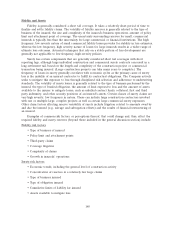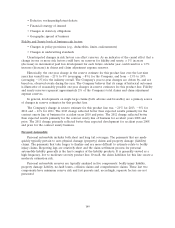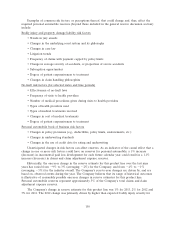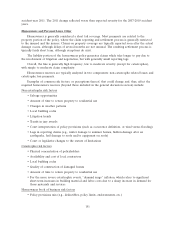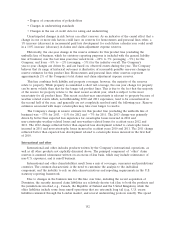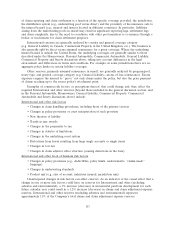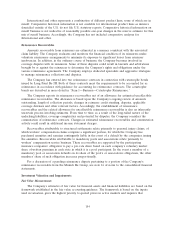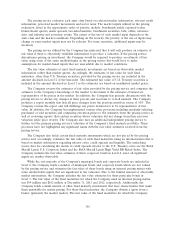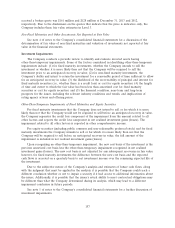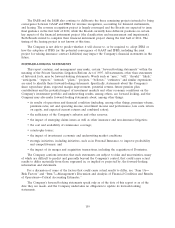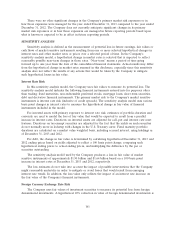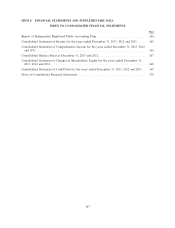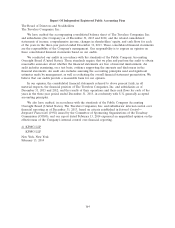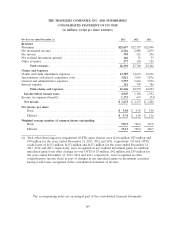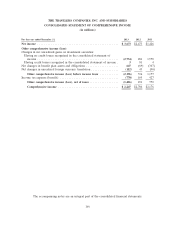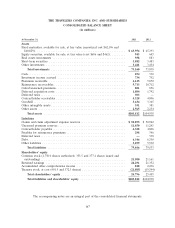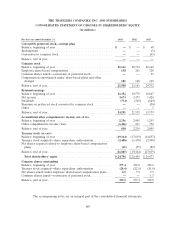Travelers 2013 Annual Report Download - page 168
Download and view the complete annual report
Please find page 168 of the 2013 Travelers annual report below. You can navigate through the pages in the report by either clicking on the pages listed below, or by using the keyword search tool below to find specific information within the annual report.Goodwill and Other Intangible Assets Impairments
See note 1 of notes to the Company’s consolidated financial statements for a discussion of
impairments of goodwill and other intangible assets.
OTHER UNCERTAINTIES
For a discussion of other risks and uncertainties that could impact the Company’s results of
operations or financial position, see note 16 of notes to the Company’s consolidated financial
statements and ‘‘Item 1A—Risk Factors.’’
FUTURE APPLICATION OF ACCOUNTING STANDARDS
See note 1 of notes to the Company’s consolidated financial statements for a discussion of recently
issued accounting standards updates.
The Company is currently required to prepare its financial statements in accordance with U.S.
Generally Accepted Accounting Principles (GAAP), as promulgated by the Financial Accounting
Standards Board (FASB). During the last several years, the Securities and Exchange Commission (SEC)
has been evaluating whether, when and how International Financial Reporting Standards (IFRS) should
be incorporated into the U.S. financial reporting system. Before making a decision, the SEC set forth a
work plan to evaluate the remaining differences between GAAP and IFRS, determine whether IFRS
represented high quality standards, consider how the International Accounting Standards Board is
funded and its governance structure, and examine the variations in the way IFRS was applied by
various foreign companies that file financial statements with the SEC. In July 2012, the SEC staff
issued a final report on the SEC work plan which concluded that IFRS provide high quality accounting
standards, but also indicated concerns with funding, consistency of application and enforcement of
IFRS globally. The report did not give a recommendation to the SEC on whether, when and how IFRS
should be incorporated into the U.S. financial reporting system. Additionally, the SEC has not
indicated a timeline for further consideration of incorporating IFRS.
The International Accounting Standards Board (IASB) and the FASB have a convergence program
with the intent of developing global standards for several significant areas of accounting, including the
accounting for insurance contracts. In June 2012, the FASB issued a statement that indicated that based
on the nature and totality of differences between the FASB’s and IASB’s views, it is not likely that the
two boards will achieve convergence on this project. The FASB further noted that the FASB and IASB
have very different perspectives on the project, given that the U.S. has existing guidance on insurance
contracts whereas there is currently no comprehensive IFRS accounting standard for insurance
contracts. In June 2013, each board issued for comment an exposure draft of the accounting for
insurance contracts that has significant differences from the other board’s draft as well as from current
GAAP. Both exposure drafts propose changes that, if ultimately adopted, could significantly impact the
accounting by insurers, including the Company, for premiums and unearned premium reserves, the
liability for claims and claims adjustment expenses, reinsurance, and deferred acquisition costs. The
Boards are reviewing the comments received on the exposure drafts and are expected to begin
re-deliberations in the first quarter of 2014. As a result of this, it is currently unclear what changes, if
any, may be made to the accounting for insurance contracts under GAAP as a result of this project.
Additionally, any new standards issued by the Boards regarding insurance contracts may involve
methodologies for valuing insurance contract liabilities that may be significantly different from the
methodologies required by current U.S. GAAP. It is also possible that the Boards could issue different
final standards that could result in the Company having to apply an accounting standard for its
consolidated financial statements that is different from the accounting standard used for local reporting
in foreign jurisdictions.
158


